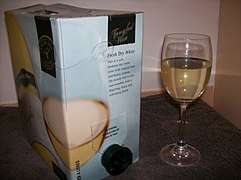Box wine
Boxed wine (cask wine) is wine packaged in a bag-in-box. Wine is contained in a plastic bladder typically with an air-tight valve emerging from a protective corrugated fiberboard box. It serves as an alternative to traditional wine bottling in glass with a cork or synthetic seal.

Alternative names
When removed from the outer box, the product may be referred to as a goon, goon bag[1][2] or "Chateau Cardboard" in Australia.[3]
History
The process for packaging 'cask wine' (boxed wine) was invented by Thomas Angove, a winemaker from Renmark, South Australia, and patented by his company on April 20, 1965.[4] Polyethylene bladders of one gallon (4.5 litres) were placed in corrugated boxes for retail sale. The original design required that the consumer cut the corner off the bladder, pour out the serving of wine and then reseal it with a special peg[5] and was based on a product already on the market, which was a bag in a box used by mechanics to hold and transport battery acid.[6]
In 1967, Australian inventor Charles Malpas and Penfolds Wines patented a plastic, air-tight tap welded to a metallised bladder, making storage more convenient. All modern wine casks now use some sort of plastic tap, which is exposed by tearing away a perforated panel on the box. For the next decades bag in a box packaging was primarily preferred by producers of less expensive wines as it is cheaper to fabricate and distribute than glass bottles.
During the mid-1970s, the bag in box packaging concept expanded to other beverages including spring waters, orange juices, and wine coolers, however, today wine and spring water are the main two beverages packed into these bags.
In 2003, California Central Coast AVA based Black Box Wines introduced mass premium wines in a box. Within the decade, premium wineries and bottlers began packaging their own high-quality boxed wine. This coupled with an increased cultural interest in environmentally sustainable packaging has cultivated growing popularity with affluent wine consumers.[7]
Attributes
Bag-in-box packaging is less expensive and lighter than glass-bottled wine. Tyler Colman from New York Times opined that it is more environmentally friendly than bottled wine [7] as well as being easier to transport and store. Typical bag-in-box containers hold one and a half to four 750 ml bottles of wine per box, though they come in a wide variety of volumes.
The fact that wine is removed from the flexible bag without adding air to fill the vacated space greatly reduces oxidation of the wine during dispensing. Compared to wine in a bottle which should be consumed within hours or days of opening, bag-in-box wine is not subject to cork taint and will not spoil for approximately 3–4 weeks after breaking the seal.[8]
Wine contained in plastic bladders are not intended for cellaring and should be consumed within the manufacturer printed shelf life. Deterioration may be noticeable by 12 months after filling.[9]
See also
- Goon of Fortune
- Wine cask
- Flavored fortified wine
- Jug wine, inexpensive table wine
References
- McClintock, Alex (2 March 2015). "Happy Birthday Goon: Cask Wine Turns 50'". The Guardian. Retrieved 2 March 2015.
- "Wine cask". Powerhouse Museum. Retrieved 5 March 2007.
- "chateau cardboard | Definition of chateau cardboard in English by Oxford Dictionaries". Oxford Dictionaries | English. Retrieved 2017-12-20.
- Crystal Ja; AAP reporters (13 September 2009). "Eclectic mix honoured on Australia Day". The Sydney Morning Herald. Retrieved 12 March 2012.
- "Wine cask". Powerhouse Museum. Retrieved 27 January 2008.
- "Who Invented The Wine Cask (Goon Box)?". Good Goon Guide. 2017-08-06. Retrieved 2017-08-26.
- Colman, Tyler, Drink Outside the Box; The New York Times (August 17, 2008).
- Lonvaud-Funel, A. (1999). Lactic acid bacteria in the quality improvement and depreciation of wine. Konings W.N., Kuipers O.P., In ’t Veld J.H.J.H. (eds) Lactic Acid Bacteria: Genetics, Metabolism and Applications. Springer, Dordrecht.
- The Oxford Companion to Wine. "boxes, wine". winepros.com.au. Archived from the original on 2008-09-05.